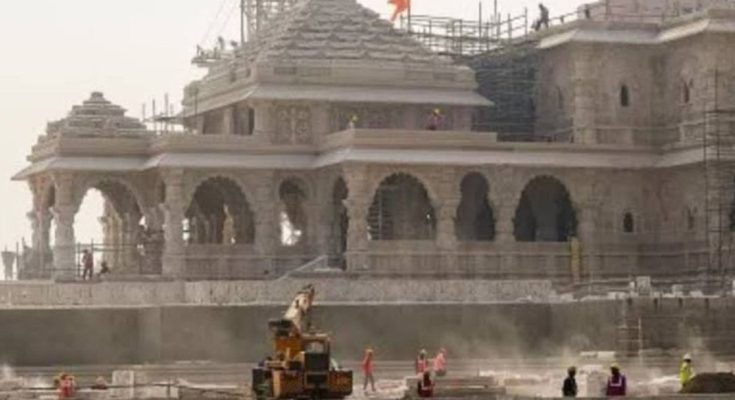Shri Ram Mandir Construction: Shri Ram Mandir construction has been technically assisted by atleast four leading National Institutes of CSIR (Council of Scientific & Industrial Research) and DST (Department of Science & Technology) under Ministry of Science & Technology, in addition to certain inputs from other institutions like IITs as well as ISRO (Indian Space Research Organisation).
Disclosing this here today, Union Minister of State (Independent Charge) Science & Technology; MoS PMO, Personnel, Public Grievances, Pensions, Atomic Energy and Space, Dr Jitendra Singh said, the four institutes which made a significant contribution include CSIR -Central Building Research Institute (CBRI) Roorkee; CSIR – National Geophysical Research Institute (NGRI) Hyderabad; DST – Indian Institute of Astrophysics (IIA) Bengaluru and CSIR-Institute of Himalayan Bioresource Technology (IHBT) Palampur (HP).
CSIR-CBRI Roorkee has majorly contributed towards Ram Temple construction; CSIR-NGRI Hyderabad gave significant inputs on foundation design and seismic safety; DST-IIA Bengaluru provided technical support on Sun’s path for Surya Tilak and CSIR-IHBT Palampur has made tulips bloom for the divine Ram Mandir Pran Pratishtha ceremony in Ayodhya on 22nd January, said the Union Science Minister.
Dr Jitendra Singh said, the main temple building, which is 360 ft long, 235 ft wide and 161 ft high, is made of sandstone quarried from Bansi Pahadpur, Rajasthan. Cement or iron and steel is not used anywhere in its construction. The Structural Design of the 3-storey temple is designed earthquake resilient and can withstand strong tremors of magnitude 8 on the Richter scale for as long as 2,500 years, he said.
“CSIR-CBRI Roorkee has been involved in the construction of Ram Mandir since early stages. The Institute has contributed towards Structural Design of the main temple, designing Surya Tilak mechanism, design vetting of temple foundation, and Structural Health Monitoring of main temple,” he said.
Dr Jitendra Singh said, besides CBRI, the CSIR-NGRI Hyderabad also gave significant inputs on foundation design and seismic/ earthquake safety. Few IITs were also part of expert advisory committee and even Space technologies from ISRO have been used in the construction of the grandiose structure, he said.
A unique feature of the Ram Temple, said Dr Jitendra Singh, is the Surya Tilak mechanism, designed in such a way that the Sun rays will fall on the forehead of Lord Ram’s Idol at 12 noon on Sriram Navami day every year for about 6 minutes. Ram Navami, celebrated on the ninth day of the first month of the Hindu calendar, which is usually in March-April, marks the birthday of Lord Rama, the seventh incarnation of Lord Vishnu, he said.
The Science & Technology Minister said, Indian Institute of Astrophysics Bengaluru provided technical support on Sun’s path and Optica, Bangalore is involved in manufacturing of the lenses and brass tubes.
“Gear box and reflective mirrors/lenses have been arranged such that sun rays from Third floor near shikara will be brought to Garbha Griha using well known principles of tracking Sun’s path,” he said.
CSIR will also be involved in the consecration ceremony, said Dr Jitendra Singh. In celebration of faith, unity and the spirit of devotion, CSIR-IHBT Palampur (HP) is sending Tulip Blooms to the divine Ram Mandir Pran Pratishtha ceremony in Ayodhya on 22nd January, he said.
“Tulip does not flower in this season. It grows only in Jammu & Kashmir and few other higher Himalayan regions and that too only in the spring season. The Institute of Himalayan Bioresource Technology Palampur has recently developed an indigenous technology through which tulip could be made available throughout the year, without waiting for its season,” he said.
CSIR technologies are also being widely used in everyday life, said Dr Jitendra Singh, as India, under the leadership of Prime Minister Shri Narendra Modi, is on the cusp of rising as an Atmanirbhar and VikasitBharat@2047 during the Amritkaal.
Dr Jitendra Singh said, CSIR labs spread across the country represent the modern day monuments of New India. Indian Institute of Integrative Medicines (IIIM) Jammu is leading the Aroma Mission and Purple Revolution, he said.
Similarly, the Minister informed that the National Botanical Research Institute (NBRI) Lucknow has developed a new lotus variety named ‘NBRI Namoh 108’. The Namoh 108 lotus variety flowers from March to December and is rich in nutrients. This is the first lotus variety whose genome is completely sequenced for its characteristics,” he said.
Dr Jitendra Singh said, PM Modi has in the last ten years stressed on the fusion of traditional and modern knowledge through an extended integration of all schools of thought.
“India has jumped from being the tenth largest economy to being the fifth, soon we shall be the fourth largest economy and then the third largest economy in the world,” he said.




